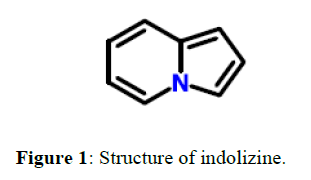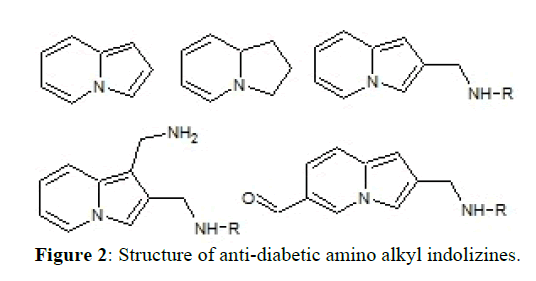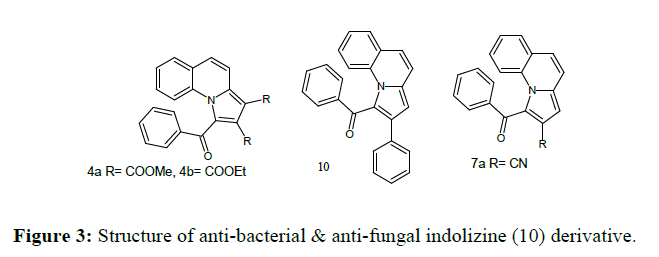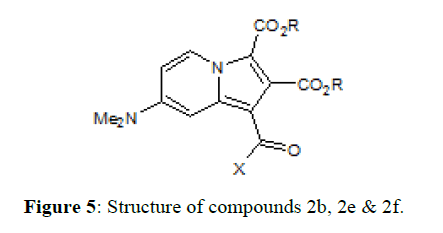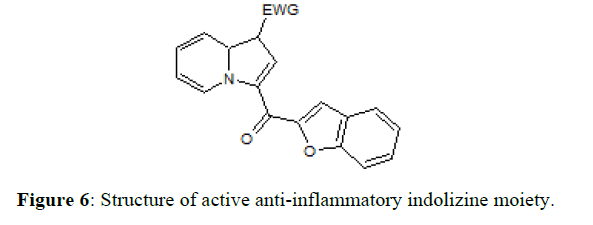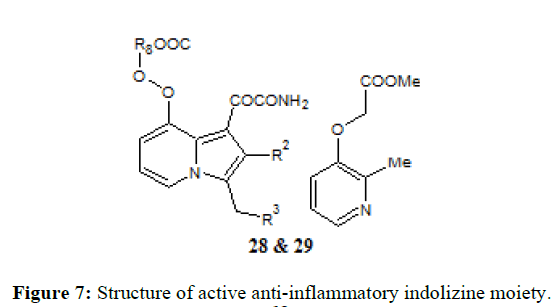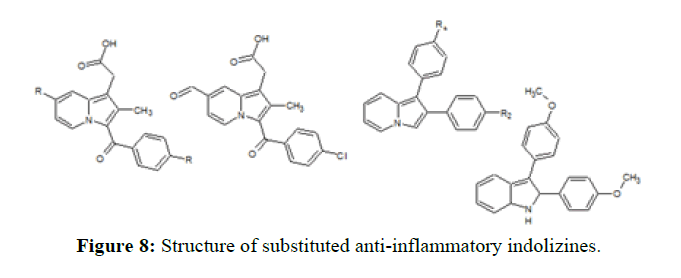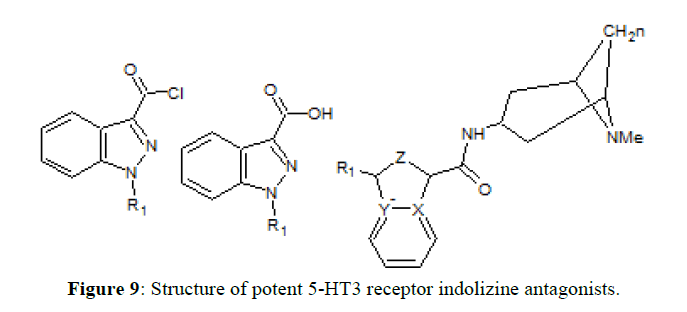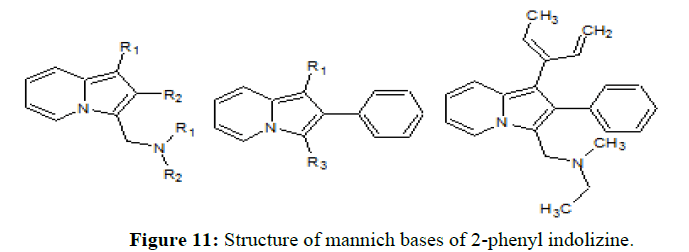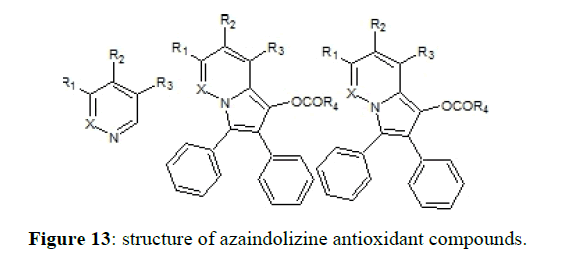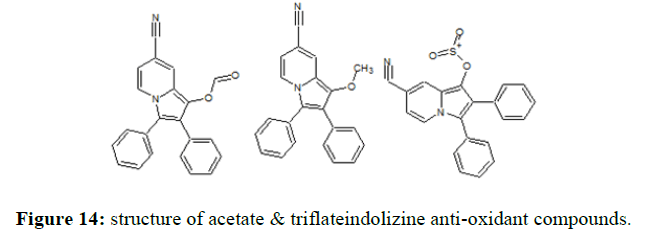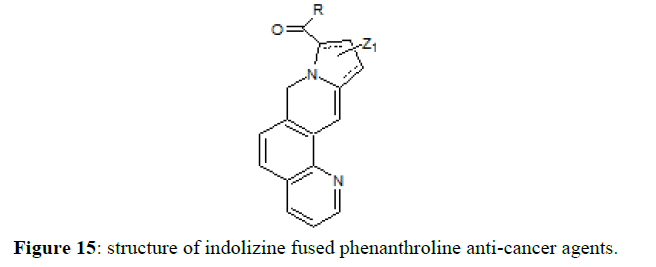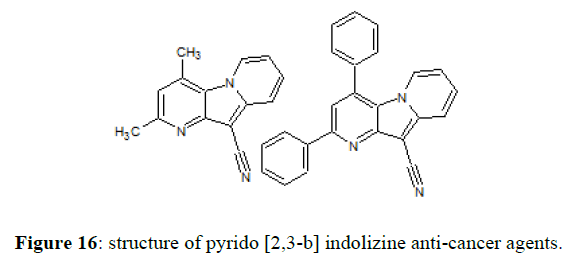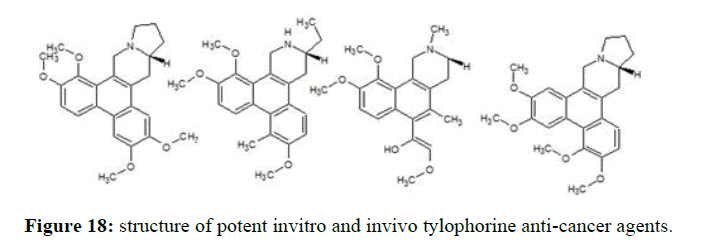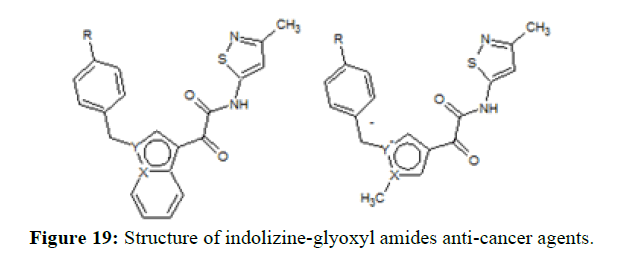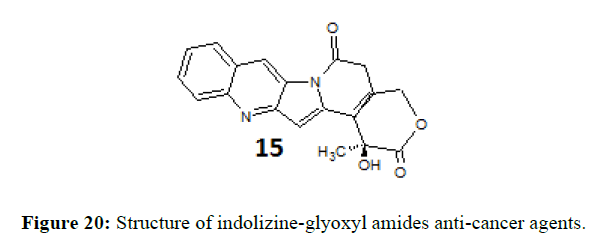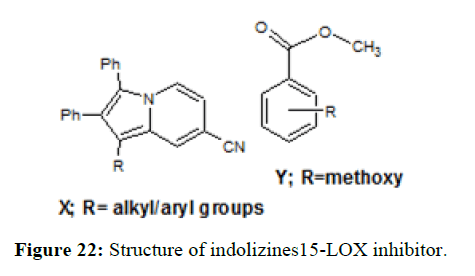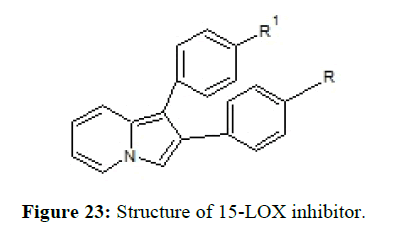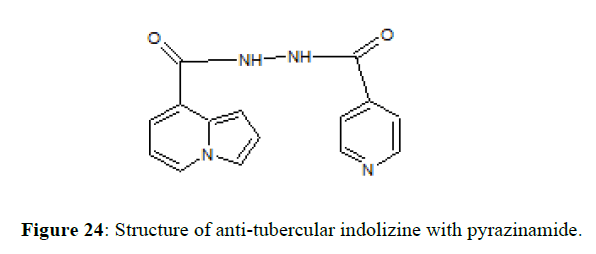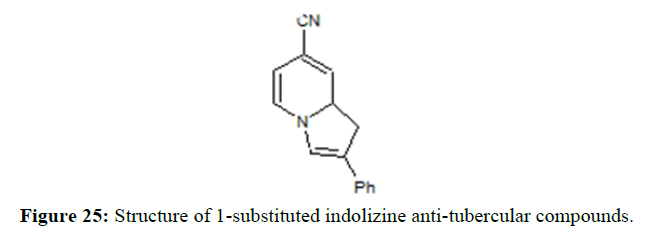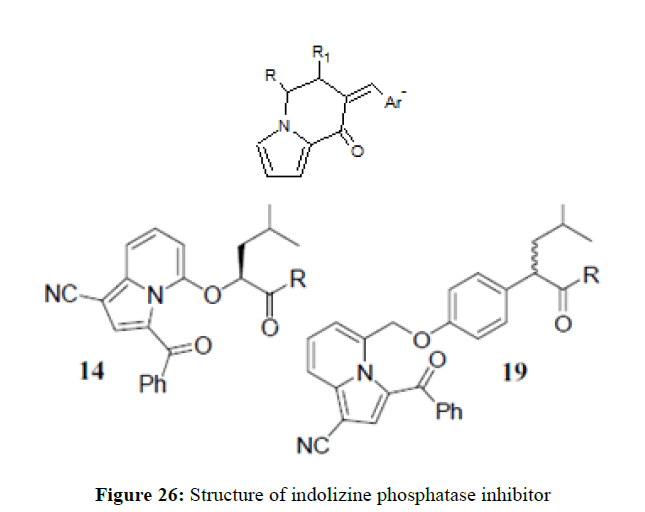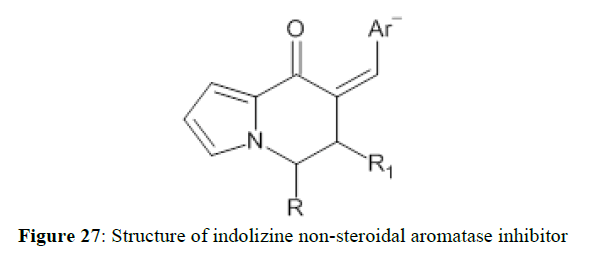Review Article - Der Pharma Chemica ( 2021) Volume 13, Issue 2
Indolizine- A Privileged Biological Scaffold
Ramalakshmi N1, Amuthalakshmi S1*, Yamuna R2, Anton Smith A3 and Arunkumar S42Associate Professor, Department of Sciences, Center of Excellence in Advanced materials and Green Technologies, Amrita Vishwa Vidyapeetham University, Amrita School of Engineering, Amrita nagar PO, Coimbatore-641112, India
3Associate Professor, Department of Pharmacy, Annamalai University, Annamalai Nagar-608002, India
4SRM Modinagar College of Pharmacy, Modinagar, India
Dr. Amuthalakshmi S, Associate professor, Department of Pharm. Chemistry, C.L. BaidMetha College of Pharmacy, Chennai-600097, India, Tel: 91- 9894893066, Email: amuthaaris@gmail.com
Received: 03-Feb-2021 Accepted Date: Feb 20, 2021 ; Published: 26-Feb-2021
Abstract
Indolizine derivatives own cherished biological activities and have been studied for their hypoglycemic, antimicrobial, anti-inflammatory& analgesic, anti-tumour activities. Indolizine scaffold has fascinated speculation and continuing interest and has become an important parent system for the development of potent new drug candidates. The conjugated planar electronic structure exhibits strong fluorescence properties which serve as a valuable tool for DNA interaction and spectroscopic sensitizer studies. Thus, the chemistry, synthesis and properties of this merged system and its derivatives have been frequently reviewed. In this review, the recently synthesized indolizine derivatives possessing important pharmacological activities have been highlighted.
Keywords
Indolizine, Drug candidates, Heteroaromatic, Spectroscopic sensitizer
Introduction
Heterocyclic compounds with a pyrrole nucleus are significantly important skeletons in biological and pharmaceutical research [1-4]. Indolizine (Figure 1) is the structural and chemical isomer of indole with two condensed rings (5-and 6-membered) and a bridging nitrogen atom [5]. Indolizine scaffold has fascinated speculation and continuing interest and has become an important parent system for the development of potent new drug candidates [6-8].
These N-fused heterocyclic aromatic compounds are isoelectronic with indole and also structurally related to purines. Indolizine moiety is considered as a 10-π electron system and modifications of the moiety were reported with wide-ranging pharmacological activities. The conjugated planar electronic structure exhibits strong fluorescence properties which serve as a valuable tool for DNA interaction [9,10] and spectroscopic sensitizer studies[11-23]. Numerous bioactive indolizines were reported to possess various pharmacological activities like hypoglycemic [24-29] analgesic and anti-inflammatory [30-34]. Interestingly it is also, reported to have 5HT3 receptor antagonist [35], anti-acetylcholine; [36], CNS depressant activity [37-39], estrogen receptor binding [40] and anti-oxidant property[41]. Moreover, indolizines are the structural analogs of many amino acid derivatives with anticancer activity [42-50]. Some reviews on synthesis of α-hydroxy benzyl substituted indolizine derivatives were proved with 15-LOX inhibitors [51,52].
Indolizine derivatives are renowned as a vital class of hetero aromatic compounds, their ring systems being a near-ubiquitous component of physiologically active natural products, well-known in different kinds of plants, animals and marine organisms [53-56]. Furthermore the structural framework of indolizine core was reported with activities such as a potent anti-osteoporotic agent [57], phosphatase inhibitor [58] aromatase inhibitor activity [59].
Recent Synthetic Developments and Reactivity
Indolizines are privileged compounds that have acknowledged significant attention in modern organic synthesis [60-63]. The striking structural similarity between the indole and indolizine nucleus prompted this speculation [64-66]. Furthermore, the indolizine core offers a wider platform for the synthesis owing to the diverse structural feature advantages such as heterocyclic π-electron rich architecture, dense aromaticity, planarity, physiologically compatible polarity, and protonation site and fluorescence property [67-69].
The traditional simple convenient [70,71] solvent-free eco-friendly approaches [72-74] microwave irradiation [75-77] sonication are recent green chemistry techniques used for the synthesis of these biologically important indolizine compounds. Recent research reports concerning synthesis of indolizines of much research, owing to the great interest primarily derived from the presence of these heterocyclic structures in several alkaloids isolated from the skin extracts of Neotropical frogs. Polycyclic fused six- and seven-membered heterocycles with indolizine indole core were synthesized by Cascade annulation reactions.
Tschitschibabin reaction, cyclo addition reactions (1,3-dipolarcycloadditions),intramolecular cyclization and cyclo isomerization transformation approaches are commonly employed for the synthesis of aromatic indolizines. Some of the novel enantio selective preparation strategies of indolizine derivative have been published by sharma and kumar. By the annulation methods, N-hydroxyindolizines able to afford the desired indolizine compounds with excellent regio selectivity. Partially or completely reduced indolizine analogs are widely used in the synthesis of indolizidine alkaloids and related unnatural products. Among many other pharmacological uses, polycyclic analogs of indolizine, have found a broad application as heterocyclic analogs of indene in the synthesis of ligands for transition metal complexes. 1, 3-dipolar cycloadditions, 1, 5-dipolar cyclo additions and one-pot addition reactions are the most common classical methods used for the synthesis of various indolizine analogues. The indolizine core could be accessible starting from pyrrole, with strategies involving intra molecular aldol cyclization or domino Knoevenagel condensation.
Interestingly, strong fluorescence property of the moiety obliges a platform for the blueprint exemplary of Switchable biosensors. Many indolizine derivatives have been proven to be key therapeutic agents, with a number of them undergoing clinical trials. Notably, a potential HIV-1 integrase inhibitor with a significant activity has also been reported. The encouraging structural features of indolizine moiety make it an attractive platform with diverse design possibilities. The facile replacement of substituents could lead to more in-depth perception towards their effect upon desired bioactivity, solubility, or other properties sought [78].
Indolizine Pharmacophore and Pharmacological Activity
Antidiabetic activity
De Au and Shah BP (1975) specified the aminoalkylindolizine synthesis and evaluated the compounds for hypoglycaemic and antineoplastic activity in Ehrlich ascites carcinoma. The compounds (I-V) (Figure 2) were found to possess good inhibitory activity.
Antimicrobial activity
Abhijit Hazra et al., (2011) reported the ion exchange resin mediated synthesis of indolizines, quinolines and isoquinolines. Synthesized heterocyclic derivatives were evaluated for antibacterial and antifungal studies against thirteen bacterial and four fungal strains. The results revealed that three derivatives (4a, 4b, 7a) are effective against all the thirteen strains and notably, one indolizine derivative (10) (Figure 3) showed dual anti-bacterial and antifungal efficacy [79].
Petra olejnikova and associates (2009) prepared a series of 21 derivatives of indolizine. The compounds were screened against four different bacterial strains such as Staphylococcus aureus, Mycobacterium smegmatis, Salmonella typhimurium and Escherichia coli. Additionally, the compounds were also tested for sensitivity against a model yeast Candida parapsilosis and some model filamentous fungi Aspergillus fumigatus, Alternaria alternata, Botrytis cinerea and Microsporum gypseum. Some of the derivatives showed selective toxicity to Gram-positive bacteria S. aureus. Derivative XXI has shown the highest bacteriostatic effect on the cells at the concentration of 25 μg mL−1 whereas the derivative XIII showed good antifungal activity. Significant anti-mutagenic activity was registered in case of derivative VIII (Figure 4) (50 μg/plate).
In another study, indolizine derivatives were synthesized and evaluated against a gram-negative bacterium (Escherichia coli), a gram-positive bacterium (Staphylococcus albus), while their antifungal potential was assessed against Candida albicans and Aspergillus flavus. All compounds including compound 13 exhibited moderate activity against the two tested bacterial species and Candida albicans [80].
Some synthesized Mannich bases of indolizine-1-carboxylate were tested for antimicrobial activity against Gram +ve bacteria, i.e. S. aureus, B. subtilis and Gram -ve bacteria, i.e. E. coli and P. aeruginosa and antifungal activity against C. albicans by Amit Kumar Das and Ishita Mukherjee (2006). Compounds 2b, 2e and 2f (Figure 5) have shown maximum activity (75% to 86.8%) against gram +ve and –ve bacteria, when compared to standard drugs.
Anti-inflammatory activity
Pavan Srivastava (2015) et al., reported the bio-isosteric replacement of pyridine with bicyclic Indolizine. The derivatization resulted in compounds with good anti-inflammatory activity. Five of the synthesized compounds (IND004, IND005, IND006, IND007 and IND008) showed significant inhibition of edema in carrageenan and arachidonic acid induced paw edema model at a dose equimolar to diclophenac sodium.
Kamal M. Dawood and coworkers (2006) synthesized benzofuran derivatives 3, 8a–b (Figure 6), 14b, and 17c. The derivatives were screened for anticonvulsant and anti-inflammatory activity. Some of them were found to possess anticonvulsant and anti-inflammatory activities.
Hagishita et al., synthesized indolizine derivatives with different substituents around the indolizine ring and interpreted that 1-carbamoylmethyl indolizine (compound 27) 1-oxamoyl indolizine (compound 28) and indoxam (compound 29) derivatives (Figure 7) possessed potent PLA2 inhibitory activity. Replacement of indolizine moiety with indene nucleus could result in loss of potency.
Kalman R. kallay and Robert F. doerge (1972) prepared some p-substituted 1,2-diphenylindoIizines. These compounds were designed to be investigated for possible anti-inflammatory activity. The compounds 2-(p-Methylphenyl)-l-phenyl indolizineand(-bromopheny1)-1-(p-methoxypheny1) indolizine (Figure 8) were tested for anti-inflammatory activity in a mycobacterium induced adjuvant arthritis. Both were found to be less active relative to the reference compound, indoxole.
5-HT3 Receptor Antagonists
Jose Bermudez et al., (1987) reported the synthesis of indazole and indolizine by altering aromatic nucleus with carboxylic acid led to the identification of indazoles 6a-h, and 1- and 3-indolizines 7b-d and 8, and imidazo [l,5-a] pyridines 9 and 10, as potent 5-HT3 receptor antagonists devoid of either dopamine antagonist or gastric motility stimulatory properties. From these series, 6g (BRL 43694) (Figure 9) was found to be both potent and selective and has been shown to be a very effective antiemetic agent against cytotoxic drug induced emesis both in the ferret and in man.
Anti-Acetylcholine Activity
The previous reports of 2,3-substituted indolizines by Ippolitoantonini et al., (1977) showed various encouraging biological activities such as anti-5-hydroxytryptamine, antihistamine, anti-acetylcholine, and central nervous system (CNS) depressant activities. In continuation the authors prepared some mono and di-N-substituted indolizine (Ippolitoantonini et al., 1979) (Figure 10) with little structural modification. All substances tested were found to have anti-5-hydroxytryptamine, antihistamine and anti-acetylcholine activities. Remarkably the compounds had pronounced antihistamine effect in the indolizine than in the tetrahydroindolize. On the whole, the indolizine derivatives proved to be more effective.
CNS Depressant Activity
William B. Harrell and Robert F. Doerg (1967,1968) reported a series(I-III) of synthesis of Mannich bases 2-phenylindolizines viz., I. Twelve 3-alkyl-1-dialkylaminomethyl II. Eight 3-dialkylamino methyl and III. Four 1,3-bis (dialkyl-amino methyl) derivatives (Figure 11). The compound, in doses of 10 mg/kg body weight, exerted a pronounced central nervous system depressant effect.
Estrogen binding activity
Anker Steen Jorgensen and colleagues reported a series of pyrrolo [2,1,5-c d] indolizine derivatives synthesis and estrogen receptor binding activity. Properly substituted mono- and di-hydroxyindolizine derivatives showed binding efficiency in the low nanomolar range in accordance with their structural resemblance to estrogen. The R3, R5 hydroxyl substituted derivatives of compound 6 (Figure 12) were highly potent compounds, which exhibited binding and structural features closely related to 17β-estradiol.
Antioxidant activity
Ole Benny ostby et al., (2000) prepared indolizinyl esters and azaindolizinyl esters. The ability of the derivatives to inhibit lipid peroxidation by in vitro was examined. Several compounds inhibited lipid peroxidation strongly, while the fatty acid ester 4c exhibited only weak activity. According to the author’s report the compounds with electron withdrawing substituents had strong antioxidant activity when compared with the unsubstituted compound 4a. Also, the azaindolizine 4g prepared from pyridazine was highly active, but the benzo fused analog 4h was a poor antioxidant (Figure 13). For comparison, the antioxidants rutin and cyanidine have IC50 values of 10 and 27 μM respectively, in the same hepatic microsomal Fe/ascorbate system.
Baidya M and Das AK., (2004) reported high antioxidant activity for acetates and methyl ethers of other 1-indolizinols, the methoxy compounds were prepared. The antioxidant properties of the acetate 4 and the triflate 6indolizines were examined (Figure 14). The derivatives were found to be strong inhibitors of lipid peroxidation in vitro, with IC50 values below1 μM.
Anti-cancer activity
Danac, R and associates (2015) reported a feasible study of indolizines fused with phenanthrolone skeleton. The compounds were screened against an NCI 60 human tumor cell life panel. Two derivatives (4b & 6a) (Figure 15) showed selective and significant antitumor growth inhibitory activity against breast cancer (MCF7 and T-47D) and a slightly moderate activity against some forms of Leukemia, Non-Small Cell Lung Cancer, Renal Cancer and Breast Cancer (MDA-MB-468).
Several pyrido[2,3-b] indolizine derivatives were synthesized by Boot A and colleagues (2014). Anticancer potential of the compounds was evaluated against three CRC cell lines viz., Colorectal cancer cell lines HT-29, HCT116 and RKO and two normal fibroblast cultures. The results indicate that, in general five of the indolizine derivatives displayed a higher cytotoxicity against RKO cells. Compound 4a was moderately active and compounds 4f, 4h, 4j and 4m (Figure 16) presented superior activity, with a cell viability below 50% at 25 μM.
Witold M. Bloch et al., (2011) the synthesis of six new compounds incorporating either a pyrazino [2,3-b] indolizine or indolizino [2,3-b] quinoxaline core is reported in good yield. The cytotoxicity of the six newly synthesized and three previously prepared compounds was assessed against a human glioblastomamultiforme cell line. The compound 6a-c (Figure 17) was found to possess significant anticancer activity.
Sherry R. Chemler (2009) reported the isolation of naturally occurring indolizine derivatives. He had given the setero selective synthesis of a series of tylophorine analogs. The compounds (Figure 18) exerted potent invitro and invivo activities of tylophorine.
David A. James, (2008) demonstrated the SAR studies of a series of indole- and indolizine-glyoxyl amides and invitro anti-proliferative activities against cancer cell lines, including multidrug resistance (MDR) phenotypes. The invitro cytotoxic effects have been demonstrated across a wide array of tumor types of various origins (e.g., breast, colon, uterine) including cell lines that show resistance to Taxol. 5b (Figure 19) was effective against all cell lines including the multidrug resistant cell lines MES-SA/ DX5 and HL60/TX1000 which were resistant to treatment with Taxol.
Sabrina Dallavalle and associates a new series of oxy imino methyl derivatives in position 7 of camptothecin (CPT) was prepared. The compounds were tested for their cytotoxic activity invitro against H460 non-small lung carcinoma cell line, the activity being for 24 out of 37 compounds in the 0.01-0.3íM range. The in vivo antitumor efficacy of the most potent analogue (15) was evaluated in direct comparison with topotecan using human lung tumor xenograft models. In the range of optimal doses (2-3mg/kg), the improved efficacy of 15 (Figure 20) was documented in terms of inhibition of tumor growth and rate of complete response.
Mansukh C. Wani and co-workers reported a facile synthetic route of series of active enantiomers of indolizine. The synthesized isomers were resolved by HPLC and for the first time the comparison of invitro cytotoxic and invivo L-1210 antileukemic activity of 20(R) and 20(S)-camptothecin was carried out. These findings suggested that only the 20(S)-camptothecin (1b) (Figure 21) exhibited desired antitumor activity.
15-LOX Inhibitors
Vikas Sharma and Vipin Kumar found that indolizine derivatives (Figure 22) were identified as 15-lipoxygenase (15-LOX) inhibitors by pharmacophoric modeling approach tool.
Solomon Teklu and associates A number of indolizine 1-sulfonates have been prepared by cyclization of cyclopropenones with pyridines followed by trapping of the intermediate 1-indolizinol with a sulfonyl halide, and examined as inhibitors of 15-lipoxygenase (15-LO). The compounds display IC50 values between 15 and 42 μM; all are more active than the well-known 15-LO inhibitor quercetin (IC50 51 lM). A wide variety of substituents are well tolerated. The enzyme inhibition was not affected by pre incubation or the presence of a detergent and no significant particle formation was observed. Hence, inhibition from aggregates of indolizines, promiscuous inhibition, is highly unlikely (Figure 23).
Anti-tubercular activity
The striking structural similarity of indolizines with pyrazinamide suggested the possibility of combination of indolizines with popular antitubercular drugs like isoniazid, Pyrazinamide, Ethionamide for SrikanthLingala et al., as anti-tubercular drugs. Anti-tubercular activity of the compounds was determined by Micro Plate Alamar Blue Assay (MABA) method against H37 Rv Strains of Mycobacterium tuberculosis at a concentration of 25 μg/ml and 50 μg /ml. Out of all synthesized derivatives only compound (V)IND-INH (Figure 24) has shown more significant anti-tubercular activity. The synthesized derivatives were also screened for antibacterial activity against E.coli, P.aeruginosa, S.aureus and E. fecalis. All the synthesized compounds have shown antimicrobial activity.
The urgent need of novel anti-tubercular drugs can be judged from the fact that in the last 40 years, no new TB drug has been developed (Zhang, 2005). In order to explore the anti-myco bacterial potential of indolizine, Gundersen et al., 2003 synthesized and tested 1-substituted indolizine derivatives (Figure 25) for their activity against Mycobacterium tuberculosis is H37Rv. Interestingly, the authors claimed compound 14 as the first anti-mycobacterial indolizine with MIC value = 6.25 lg/ml. The author highlighted the presence of hydroxyl and phenyl group(s), which may be responsible for the anti-tubercular action and stressed that this could be a lead molecule of the future toward the synthesis of better anti-mycobacterial indolizine derivatives.
Anti-Osteoporotic Agent
Yu TY, Pang WJ and Yang GS group reported the condensation 3,3'-Diindolylmethane (DIM). This study evaluated the effect of DIM on bone mass in mice under physiological and pathological conditions. Our results demonstrated that DIM increased bone mass by suppressing osteoclastic bone resorption in bone metabolism under both physiological and pathological conditions. Accordingly, DIM may be of value in the treatment and the possible prevention of bone diseases characterized by bone loss, such as postmenopausal osteoporosis.
Phosphatase inhibitor
TimoWeide et al., synthesized a series of 3-substituted indolizine-1-carbonitrile derivatives. Some of them displayed activity against MPtpA/MPtpB phosphatases, involved in infectious diseases. These data also make clear that the 5-(phenoxymethyl) indolizine scaffold provides a promising lead structure. The scaffold 14 was found to inhibit MPTPB but not MPTPA, while compound 19 (Figure 26) was found to be10-fold more selective for MPTPB.
Non-Steroidal Aromatase Inhibitors
Pascal Sonnet and coworkers described the design and the synthesis of some aryl-substituted pyrrolizine and indolizine derivatives, on the basis of a hypothetical pharmacophore structure designed to the catalytic site of the human cytochrome P450 aromatase. The invitro biological evaluation of these compounds allowed us to point out two new potent non-steroidal aromatase inhibitors, MR 20494 and MR 20492, with IC50 values in the range of 0.1 mM. Compounds 28 (MR 20494) and 29 (MR 20492) (Figure 27) were very potent inhibitors of human aromatase, slightly less than Fadrozole.
Conclusion
The available data in the literature reveals that indolizines constitute a significant class of heterocycle that possess numerous promising biological activities including hypoglycemic, antimicrobial, analgesic and anti-inflammatory activity, 5HT3 receptor antagonist, anti-acetylcholine, CNS depressant activity, estrogen receptor binding, anti-oxidant and anti-cancer activity. In particular, pyrrole ring in indolizine has emerged as a template molecule potentially to be used in numerous drug discovery and research. There are various reported methods available for the synthesis of indolizine and its derivatives, including one pot synthesis, biocatalyst assisted, microwave irradiation, ultrasonication and solvent free synthesis, and other environmentally benign methods that can be adapted more easily.
The activity described in this review would likely be proved to be useful for researchers looking for suitable substitutions while designing a potent molecule of interest. In summary the fused indolizines with other heterocyclic moiety was effective against all cancer cell lines. Notably, additional nitrogen in the five membered ring and substituted esters showed anti-oxidant activity. The substitutions in the five membered rings with acyl, carboxyl and mannich bases were proved with hypoglycaemic, anti-microbial and anti-inflammatory activity. Coupling of indolizine with anti-tubercular drugs were reported with anti-tubercular activity. Similarly the substitutions in the six membered rings also offered interesting activities like aromatase and phosphatase inhibitory activity.
This review provides groundwork information and will greatly help to discover better and highly efficient, easily available indolizine derivatives. Later, we can conclude that many other derivatives, their stereo isomers and complexes which may be a potent and effective pharmacological scaffold in future.
Conflict Of Interest
The authors declare no conflict of interest for the present review.
References
- WB Harrell and RF Doerge, J Pharm Sci. 1967, 56: p. 225.
- FJ Swinbourne, JH Hunt and G Klinkert, United Kingdom edition, 1979.
- MA Yurovskaya and RS Alekseyev, Chem Heterocyc Compd. 2013, 1507.
- YQ Ge, XY Gong, GJ Song, Et.al.,Spectrochim Acta A. 2015,135, 7.
- DA Kuntz, S Nakayama, K Shea, H Hori, Et.al., Chem Bio Chem. 2010, 11: p. 673.
- TP Singh and OM Singh, Mini-Rev Med Chem. 2017, 18: p. 9.
- RV Gradinaru, AM Luca and ICretescu, R. Rev Chim-Bucharest. 2010, 61: p. 903.
- E Kim, S Lee and SB Park. Chem Commun. 2011, 47:p. 7734.
- Hou Li-Mei, Wen Zhi, Li Yin-Xiang, et.al., ActaPhysico-Chim Sin. 2015, 31: p. 1504.
- AJ Huckaba, A Yella, P Brogdon, et.al., Chem Commun. 2016, 52: p. 8424.
- LE McNamara, TA Rill, AJ Huckaba, et.al., Chem Eur J. 2017, 23:p. 12494.
- N Ohta, K Awasthi, K Okoshi, et.al., J Phys Chem. 2016, C120:p. 26206.
- Amit Kumar Das and Ishita Mukherjee, Orien J Chem. 2006, 22:p. 339.
- AU De and BPSaha, J Pharm Sci. 1973, 62: p. 1897.
- LL Gundersen, C Charnock, AH Negussie, et.al., Eur J Pharm Sci. 2007, 30:p. 26.
- A Hazra, S Mondal, A Maity, et.al., Eur J Med Chem. 2011, 46:p. 2132.
- P Olejníkova, L Birošová and L Švorc. Sci Pharm. 2009, 77: p. 216‑216.
- KM Dawood, H Abdel-Gawad, EA Rageb, et.al., Bioorgan Med Chem. 2006, 14:p.3672.
- KR Kallay and RF Doerge. J Pharm Sci. 1972, 61:p. 949.
- RG Kurumbail,AM Stevens, JK. Gierse, Et.al., Nature. 1996, 384: p. 644.
- Sanji Hagishita, Masaaki Yamada, Kazuhiro Shirahase, et.al., J Med Chem. 1996, 39: p. 3636.
- SK Shrivastava, P Srivastava, R Bandresh, et.al., Med Chem. 2017, 25:p. 4424.
- J Bermudez, CS Fake, GF Joiner, et.al., J Med Chem. 1990, 33:p.1924.
- I Antonini, M Cardellini, FClaudi, et.al., J Pharmaceutical Sciences, 1977, 66: p.1692.
- I Antonini, F Claudi, UGulini, et.al., J Pharm Sci. 1979, 68: p. 321.
- WB Harrell and RF Doerge. J Pharm Sci. 1967, 56:p.1200.
- WB Harrell and RF Doerge. J Pharm Sci. 1968, 57:p. 1989.
- AS Jorgensen, P Jacobsen, LB Christiansen, et.al., Bioorgan Med Chem Lett. 2000, 10:p. 2383.
- OB Ostby, B Dalhus, LL Gundersen, et.al., Eur J Org Chem. 2000, p. 3763.
- G Ayache, EM Ayache, AK ImprLaballery, et.al., J Heterocyclic Chem. 1996, 14: p. 81.
- WM Bloch, SM Derwent-Smith, FIssa, et.al., Tetrahedron. 2011, 67: p. 9368.
- A Boot, A Brito, T Van Wezel, et.al., Anticancer Res. 2014, 34:p. 1673.
- S Chemler, Curr Bioact Compd. 2009, 5: p. 2.
- R Danac, CM Al Matarneh, S Shova, et.al., Bioorgan Med Chem.2015, 23: p. 2318.
- DA James, K Koya, H Li,Et.al.,Bioorgan Med ChemLett. 2008, 18:p. 1784.
- Dallavalle Sabrina, Penco Sergio, Pisano Claudio, et.al., Canadian Patents 2. 2011,51: p. 7450.
- MC Wani, AW Nicholas and ME Wall. J Med Chem. 1987, 30: p. 2317.
- OB Ostby, LL Gundersen, F Rise, et.al., Archiv der Pharmazie. 2001, 21: p. 334.
- V Sharma and V Kumar. Bull Fac Pharm Cairo Univ [De-600]. 2015, 53:p. 63.
- V Sharma and V Kumar. Med Chem Res. 2014, 23:p. 3593.
- AR Katritzky and CW Rees. Comprehensive Heterocyclic Chemistry, Pergamon; 1st edition, 1984.
- ML Bode and PT Kaye. J Chem Soc. 1993, 10:p. 1809.
- CK Sandeep, N Venugopala, MA Khedr, et.al., J Basic Clin Pharm. 2017, 8.
- P Tielmann and CHoenke, Tetrahedron Lett. 2006, 47:p. 261.
- VR Vemula, S Vurukonda and CK Bairi, Int J Pharmaceutical Sciences Review and Research. 2011, 11; p. 159.
- T Yu, W Pang and G Yang, J Pharmacol Sci. 2015, 127: p. 75.
- T Weide, L Arve, H Prinz, et.al., Bioorgan Med Chem Lett. 2006, 16:p. 59.
- P Sonnet, P Dallemagne, J Guillon, et.al., Bioorgan Med Chem. 2000, 8:p. 945.
- NS Prostakov and OB Baktibaev. Russ Chem Rev. 1975, 44: p. 748.
- WL Mosby, Heterocyclic systems with bridgehead nitrogen atoms. Part two. Interscience, 1961.
- ET Borrows and DO Holland. Chem Rev. 1948, 42:p. 611.
- JP Michael. Alkaloids Chem Biol. 2001, 55:p. 91.
- GDGoldhaber-Pasillas and YH Choi, R. Verpoorte. Adv Bot Res. 2013, 68: p. 233.
- T Niu, L Huang, T Wu, et.al., Org Biomol Chem. 2011, 9: p. 273.
- DF Taber and PK Tirunahari. Tetrahedron. 2011, 67: p. 7195.
- P Michael. Nat Prod Rep. 2007, 24:p. 191.
- JP Michael. Nat Prod Rep. 2008, 25: p. 139.
- R Molyneux and L James, Science. 1982, 216: p. 190.
- R Matczak, B Koszarna and DT Gryko, Tetrahedron. 2014, 70: p. 7006.
- T Uchida and K Matsumoto. Synthesis. 1976, 209.
- R Surasani, D Kalita and KB Chandrasekhar. Green Chem Lett Rev. 2013, 6: p. 113.
- NC Ganguly, P Mondal and SK Barik, Green Chem Lett Rev. 2012, 5; p. 73.
- MS Singh and SChowdhury. RSC Advances. 2012, 2: p. 4547.
- MS Gopal and I Anitha. Int J Chem Stu. 2014, 35: p. 35.
- J Kamalraja and PT Perumal, Tetrahedron Lett. 2014, 55: p. 3561.
- ZN Siddiqui, F Farooq and TNM Musthafa. Green Chemistry Letters and Reviews.2011, 4: p. 63.
- BM Vieira, S Thurow, JS Brito, et.al., Ultrasonics Sonochemistry, 2015, 27: p. 192.
- VGevorgyan, N Chernyak, D Tilly, et.al., Arkivoc. 2011, 2010:p. 76.
- S. Park and I Kim, Tetrahedron. 2015, 71:p. 1982.
- G Ieronimo, A Mondelli, F Tibiletti, et al., Tetrahedron. 2013, 69: p. 10906.
- C Sandeep, B Padmashali and RS Kulkarni. Tetrahedron Lett.2013, 54: p. 6411.
- P Sharma, A Kumar, S Sharma, et.al., Bioorgan Med Chem Lett. 2005, 15: p. 937.
- B Sadowski, J Klajn and DT Gryko. Org Biomol Chem. 2016, 14:p. 7804.
- I Seregin and VV Gevorgyan. Chemical Society Reviews.2007, 36:p. 1173.
- X Zhang, G Lu, Z Xu, et.al. Acs Sustain Chem Eng. 2017, 5:p. 9279.
- JH Lee and I Kim. J Org Chem. 2013, 78: p. 1283.
- AM Koskinen and OA Kallatsa. Tetrahedron. 2003, 59:p. 6947.
- W Huang, T Zuo, XLuo, et.al. Chem Biol Drug Des. 2013, 81:p. 730.
- SS Ekbote, KM Deshmukh, ZS Qureshi, et.al., Green Chem Lett Rev. 2011, 4: p. 177.
- C Sandeep, B Padmashali and RS Kulkarni. Tetrahedron Letters. 2013, 54: p. 6411.

